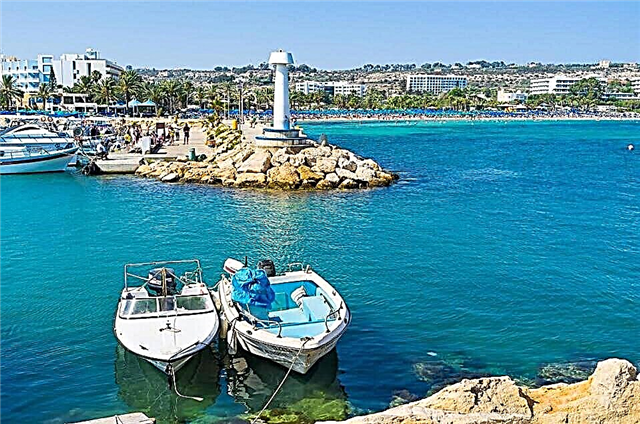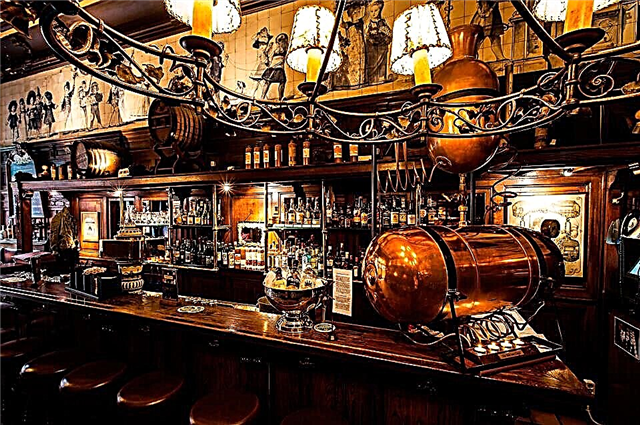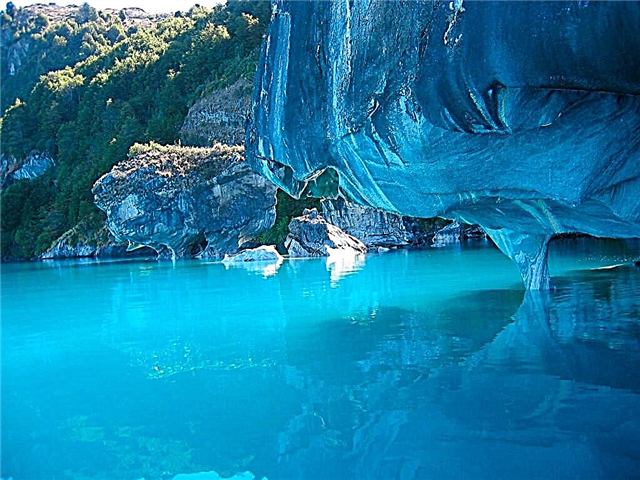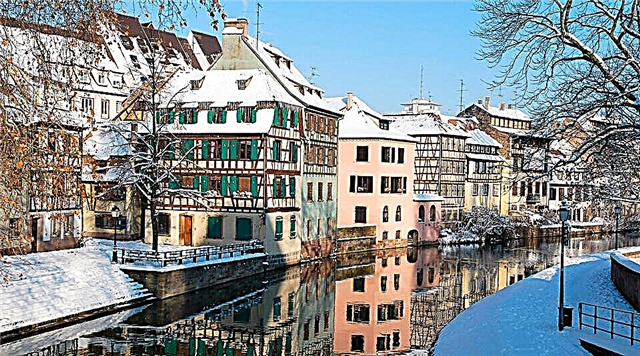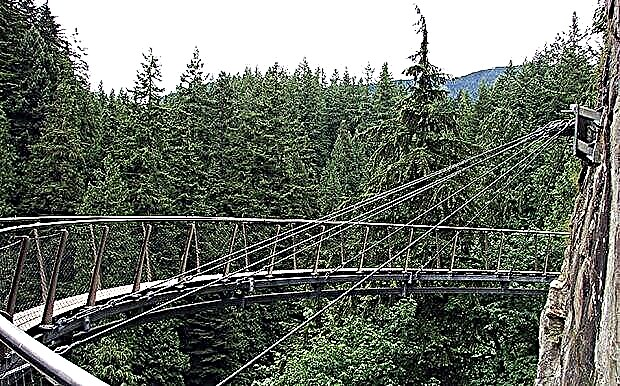Canada is a relatively young state. There are no medieval castles here, but many houses and cities keep the memory of the times of the formation of this country. Yet Canada's greatest attractions are natural wonders, renowned for their unspoiled nature and pristine purity. The country's national parks have long won fame all over the world. Therefore, tourists from all over the world strive to admire the unspoiled nature of Canada and touch the history of the formation of the country.
Cathedral of Our Lady of Montreal

Among the historical structures, the Cathedral of Our Lady of Montreal, built in 1888 by a Protestant architect, is famous for its two twin towers, each of which has its own name. One tower is called Restraint and the other is called Perseverance. In addition, the Cathedral of Notre Dame de Montreal has one of the largest bells, weighing up to 12 tons. In the Cathedral during the service, you can hear the sounds of the famous Cassavant organ, which consists of 7 thousand pipes.

The blue altar of this Catholic church amazes the imagination of those present with its unusual beauty. It is noteworthy that upon completion of the construction of the cathedral, its creator, architect James O'Donnell, was amazed at the results of his labors and, shortly before his own death, converted to Catholicism.
Oratory of Saint Joseph

Among the places of worship in Montreal, the Oratory of Saint Joseph Mont-Royal is famous for the third largest dome in the world. The initiator of the construction of the church was brother Andre Bessette, who served here and won the favor of the parishioners, healing their ailments. Brother Andre dedicated miracles of healing to Saint Joseph.
Visitors to the basilica can see thousands of crippled crutches miraculously put on their feet by Brother André. The heart of Brother André is kept in the church museum, so more than 2 million pilgrims annually strive to find healing in the temple today. To this end, true pilgrims climb the 99 steps of the church solely on their knees.
Upper Canada Vllidge

Upper Canada Vllidge near Ottawa gives tourists the opportunity to travel to the 1860s and get acquainted with the lifestyle and life of the inhabitants of these places of those distant times. Houses, shops, mills, blacksmiths, bakery, furniture workshop - everything corresponds to the spirit of 19th century America. Even the villagers are dressed in the fashion of that era.
In addition to the usual excursions, tourists can take part in the life of the village: take a ride in a horse-drawn carriage, taste a photo studio, taste village treats in an old hotel, or buy cheddar cheese made at a local cheese factory and handicrafts of village crafts from a local store.
Suspension bridge Capilano

Another attraction of Canada is the Capilano suspension bridge, built back in 1889 from cedar planks and hemp rope. In 1956, the bridge had to be completely rebuilt, as for a long time it became completely unusable.
It should be noted that local residents do not use the bridge. But every year 800 thousand tourists, who want to tickle their nerves, each time go to overcome 137 meters of the path along the bridge located at an altitude of 70 meters above the Capilano River.

The Capilano Bridge is not the only attraction on Vancouver Island. On the west coast of the island, the Sitka Spruce grows, famous for its 95-meter height and the title of the tallest tree in Canada. The island's Pacific coast attracts many surfers who are keen to curb the high waves here. From the windows of local hotels, you can watch how killer whales and huge whales frolic in the ocean waters.
Bay of Fundy

You can also admire the whales by visiting the Bay of Fundy, known to every schoolchild as the bay with the highest tidal waves. Therefore, every year kayakers and canoe lovers not only from Canada, but also from other countries of the world gather here. More information in our article.
Wood Buffalo National Park

Since Canada is famous for its respect for the environment, it would be unfair to say nothing about the country's many national parks. One of the largest in the world and the largest in Canada is the Wood Buffalo National Park, a United Nations World Heritage Site.
The name of the park was not chosen by chance. In 1922, it was created precisely for the sake of preserving these powerful animals. Today, the park is home to the largest herd of wild bison, numbering more than 2.5 thousand individuals.

Here, on an area of 44 thousand kilometers among coniferous and mixed forests, shrubs and grasses, there are excellent conditions for 47 species of mammals, including the Canadian caribou and musk rats, the American black bear and wolves, beavers and muskrats. The park is home to 227 bird species, including the American crane, the great gray owl and the snowy owl. The National Park welcomes visitors at any time of the year, and each season is a unique and amazing sight to celebrate the unspoiled nature of Wood Buffalo.
There are many more unique parks in Canada, one of them is Banff National Park.
Cemetery Notre-Dame-de-Nege

On one of the slopes of Mont Royal is the largest necropolis in North America, the dimensions of which are very impressive: the length of the paths is 58 km, and the area is almost 1.5 square meters. km. The cemetery in popularity and importance is not inferior to the Parisian Pere Lachaise and Moscow Novodevichy: the most famous personalities of Canada are buried there - great artists, politicians, athletes. Cavalli is the author of the anthem of Canada, Georges Cartier is the founder of the confederation, E. Nelligan is a Canadian poet of French origin and other celebrities have found eternal rest here.

The cemetery at first served as a burial place for Catholics only, but now it is allowed to bury representatives of other religions here. Notre-Dame-de-Nege is included in the list of National Monuments of Canada and is protected by the state. Here is the ashes of the famous hockey player Maurice Richard ("Rocket"), who became a national hero of Canada for his outstanding achievements in sports and for his participation in the liberation movement in Quebec. The territory of the cemetery is very picturesque, well-groomed and spotlessly clean. Lush crowns of trees respectfully overshadow strict monuments devoid of excessive pretentiousness and pomp.
Montreal Botanical Garden
This wonderful "island" of a magnificent variety of wildlife was born in 1931 as a symbol of opposition to the Great Depression that gripped America in the late 19th and early 20th centuries. in. Montreal owes its ownership of a truly beautiful mini-sanctuary of plants and animals to then-mayor Camiyen Udo and a group of enthusiastic botanists, designers and architects who designed and implemented a project that was daring at the time.

Now the botanical garden, renewing and improving every year, is one of the best among its fellows in the number and variety of rare trees, shrubs and other vegetation. On 75 hectares, themed zones-gardens are located, representing the flora of Japan, China, and the Alps. Species-style areas are decorated: an English garden, aquatic plants, medicinal, poisonous, a garden of azaleas, rhododendrons and others - a total of 30 thematic gardens and 10 greenhouses-exhibitions.As a tribute to the memory of the aboriginal rats of Canada, the Garden of the First Nations, in which the trees typical of the north grow; plants that fed and treated the indigenous population.
The beauty and abundant variety of everything that is located here amaze and delight, discovering a lot of new things from the world of flora and fauna. Tens of thousands of roses, orchids, rhododendrons have been planted (in total, 99% of all plants from half of Canada are represented). Squirrels, ducks, herons, turtles are found in abundance. On the basis of the Garden there are research institutes of botany, an observatory, a pet zoo for children, and an insectarium.
Yoho National Park
Anyone who visits Yoho for the first time and learns the translation of the name from the Indian, completely agrees with him, because differently than "Wow!" you cannot say about these amazing places. The surrounding landscapes amaze the imagination of seasoned travelers with their original originality and majestic beauty. Here, at every step, you can exclaim with admiration: “Wow!” Seeing a sparkling glacier or a rapidly flying waterfall, an emerald-colored lake or mighty Canadian pines.

Here, many names are associated with the indigenous population: it was the Indians who christened the treacherous mountain river with a dangerous current "Lying Horse", and the famous for its height (381 m) seasonal waterfall, formed from the melting of mountain ice, "That's great!" Another, 30-meter high waterfall - "Laughing" for the sound of water, similar to the devil's laughter, is no less wittily nicknamed.
The world of fauna is unusually rich here: deer, elk, bears, badgers, roe deer are found in large numbers. A huge number of various birds (180 species) arrange bird colonies on the banks of reservoirs. For tourists, wide highways are laid here, hotels are built and a modern infrastructure has been created that allows you to have a wonderful time among the pristine nature.
Thousand Islands National Park

The one of a kind National Park "1000 Islands" is located in an unusual place: among the St. Lawrence River, starting from Lake Ontario and occupying 80 km of river bed. These extraordinary places cannot be called otherwise than a miracle of nature. If you look at the reserve from above, you get the impression that someone's mighty hand took and scattered the picturesque islands, islets and islets among the river surface. Actually, the sagacious Indians composed just such a legend, observing a natural phenomenon from the surrounding mountains: God, angry with sinful people, decided to take the Earth from them, but, raising it, dropped it, breaking it into pieces and pieces.
There is a completely scientific explanation for the origin of the "1000 Islands". According to geologists, the river, becoming more powerful and full-flowing, flooded the ancient rocky formations, leaving only their tops on the surface, which became islands. Their sizes range from 100 sq. km up to 100 sq. m. The unique archipelago is rightfully considered an invaluable natural gift, declared back in 1914 as a National Park. Soon after, the islands began to be sold, and houses were built on many of them, life "boiled". Vacationers love to come here, eager to enjoy the peace and tranquility that reign here.

The largest and most inhabited is the Wolf Island, where there is a well-developed infrastructure, quite a lot of people constantly live. A slightly smaller island is also remarkable. Hut, with a unique architectural landmark - Bolt Castle. As the romantic legend says, a certain J. Bolt built it for his beloved wife, who suddenly died. Shocked by her death, he abandoned the construction site and left here forever. Not so long ago, the current owner (who bought the island for $ 1) completed the construction of the castle and opened an interesting museum in it, which tourists willingly visit. A visit to the unusually beautiful unique biosphere reserve brings a lot of positive emotions and unforgettable impressions. Read more about the Thousand Islands Park in our article.
Lake Peyto - water turquoise among the rocks

Another natural phenomenon in Canada - alpine Lake Peyto, named after its discoverer, is located in a rocky gorge at an altitude of 1860 m above sea level in Banff National Park. The stunningly beautiful reservoir of bright turquoise color stretches 1 km 800 m long, and 800 m wide and is a mesmerizing sight. Tens of thousands of tourists strive to admire the unique lake in order to see firsthand the colorful masterpiece of nature.
The steep banks are overgrown with dense coniferous forest, creating a wonderful frame for the unique lake. In winter, it is surrounded by a silvery necklace of pines and firs covered with snow; the rest of the year, dark green velvet needles. The extraordinary color of the lake is due to the presence of special minerals that flow down along with the glacial water from the surrounding rocks and color the reservoir in a beautiful turquoise color.

Photo enthusiasts have a lot to do here, capturing enchanting landscapes from different angles. Avid fishermen will not be bored either: despite the icy water, there are many fish in the lake, which are allowed to be caught only with a fishing rod a strictly normalized number of times. (Canadians value ecological balance). Now, among this divine primordiality, comfortable camp sites have appeared, from where ascents to the mountains are organized for viewing from the peaks of the delightful panorama of Lake Peyto.
Park Sit de Le Havre in Montreal

There is a man-made peninsula in Montreal, created at the end of the 19th century to protect the city from the turbulent, eroding course of the river. San Lawrence flood threat. It was called the protective cape or pier of Makei, on which already in the 20th century. set up a cozy park on the occasion of the industrial exhibition "Expo-67". The cape was expanded with bulk crushed stone, which was mined in large quantities during the construction of the metro and connected by the capital bridge "Concord" with about. St. Helena.
Now the Sit-de-Le Havre Park is a quiet green recreation area for Montreal residents, where there is no annoying city noise, there are shady alleys for walking, beautiful bike paths. The real attraction of the cape is the architectural residential complex, built as an innovative solution on the theme "Habitat-67". His project was developed by the little-known Canadian designer of the time, Safdie, and was intended to show modern urban trends in the construction of suburban housing in unity with nature.
The massive building consists of 354 block modules, forming 146 apartments with different areas and layouts. Each of them is equipped with an individual terrace dedicated to green spaces. The unusual building became a sensation at the exhibition and the beginning of Safdie's brilliant career. And the Sit de Le Havre park is becoming more and more popular among vacationers.
Cathedral Marie-Rhine-du-Mont

This magnificent temple is a younger brother, a smaller copy of the famous Roman Cathedral of St. Peter, built in Montreal at the initiative of Bishop Ignacy Bourget. The Bishop was so impressed by the Italian cathedral that he ordered an exact copy of the Church of Peter to be erected instead of the burnt-out St. Jacob's cathedral. The architect who was entrusted with the project went to Rome, and, having examined the original, did not undertake the construction. Nevertheless, the cathedral was erected and consecrated in 1894, receiving the name Marie-Rhine-du-Mont ”(Mother of God, Lady of the World).
Now the copy of the Roman cathedral is the third largest church in the province of Quebec, declared a National Historic Site of Canada in 2000. The temple conducts all religious rites, including baptism, performed in a unique marble font with a sculptural Crucifixion, considered the standard of church sculpture in Quebec. The magnificent building of the cathedral is crowned with 13 statues of the patron saints of Montreal, next to it, on a high pedestal, the initiator of the construction, Bishop Bourget, is immortalized in bronze.

The internal interiors of the temple are beautiful, decorated with 9 paintings with plots about the history of Montreal, depicting national heroes and the stages of the formation of the faith. A remarkably executed statue of the Virgin (sculptor Sylvia Doust) is installed in the chapel of the church. The altar is equipped with a canopy - an exact copy of the Italian, created as a work of art, from gold and copper sheets, decorated with statues of angels and papal paraphernalia.
Banff National Park

The very first and largest in area of all subsequent national parks in Canada was organized in 1885 in the province of Alberta, the capital of which is the famous Calgary Winter Olympics. Banff Territory - Forested Rocky Mountains; snow-capped peaks, glittering glaciers; wonderful mountain lakes with crystal water; picturesque waterfalls, alpine meadows. Banff - tens of kilometers of ski slopes, beautiful highways, hundreds of classy hotels and campgrounds, the richest world of fauna.
Travelers from all over the world come here to see the unearthly beauty of northern nature; breathe, more precisely, enjoy the clean air with the aromas of pine needles; canoeing and gondolas, skiing. The most beautiful lakes: Peyto, Moraine, Lake Louise, Lake Crescent, which feed on glaciers, attract to themselves with their cosmic primordiality and watercolor cold beauty. The surrounding landscapes are breathtaking and heart-stopping: is such beauty really possible on Earth ?! The same beauties surround the Icefield Parkway, which links Banff to Jasper Park. It was laid back in the 70s of the last century among the most picturesque places.

The park is known for its hot sulfur springs with healing properties. On their basis, there is a Canadian bath here, where many tourists seek to get. A trip to Banff Park is a wonderful vacation and close communication with wildlife against the backdrop of magical pictures. Read more about Banff Park in our article.
Old Montreal

The most eloquent name speaks of that part of the city. which has survived since its foundation, when Montreal was still called Ville Marie (1642-1643). The future city began with a fort built under the leadership of the Frenchman Paul de Chaomedy, designed to convert the indigenous population of Canada to the Christian faith by French settlers. Gradually, the fort turned into a city with all its inherent attributes: houses, temples, a prison. Having survived numerous fires, the city survived; wooden houses were replaced by stone ones, streets and sidewalks were improved.
Until now, there are preserved old medieval street lining, architectural landmarks of the 17th-18th centuries. century, which are carefully protected by society and the state: the old hospital Hotel Dieu de Montreal, the Seminary of San Sulpice. The main architectural monument of Old Montreal is the Church of Notre Dame, built in 1829, when the British ruled Montreal, which was reflected in the style of construction. The cathedral, made not in a strictly Catholic spirit, but in a Gothic style, rises upward with its towers. The whole building seems light and airy, graceful and colorful, thanks to high stained glass windows, sculptural decoration of the facade, and arched vaults.

The magnificent building of the City Hall is also impressive - a wonderful architectural structure of the British era. One of the oldest monuments of Old Montreal deserves attention - Nelson's Column, installed in 1804 on the New Market Square. There is a Champ de Mars in the old town, which stretches from the Town Hall to the Ville-Marie highway, where the stone masonry of the fort has been preserved. Inspection of Old Montreal - a journey into the historical past of Canada.
Canadian Cordilleras

This mountainous region is an invaluable treasure of wildlife, a repository of fantastic beauty and a rich variety of landscapes. It is here that the famous Banff, Jasper, Wood Buffalo and Waterton Lakes National Parks are located, a picturesque part of the Rocky Mountains with the highest peak - Mount Robson. The Canadian Cordilleras are home to the richest storehouse of natural resources - the Whistler area; the huge Columbia glacier (an area of 325 sq. km is occupied by ice fields - natural skating rinks for sports); deep canyons Fraser, Johnston.
There is an opportunity to see the most beautiful lake in North America - Lake Louise, the mighty Athabasca, Lower and others. Scientists have discovered multiple remains of dinosaurs, which played a significant role in the interpretation of the theory of terrestrial evolution. In the ecologically clean waters of the Cordilleras, by all accounts, the best fishing. The Canadian Cordillera are of unsurpassed beauty and rich diversity of nature.

